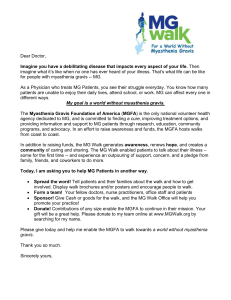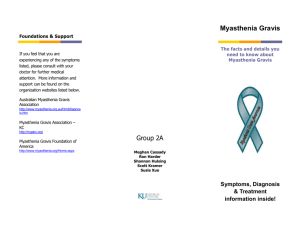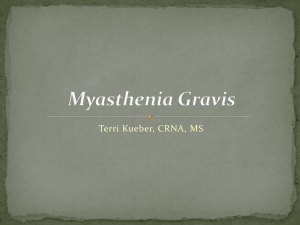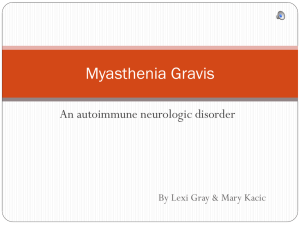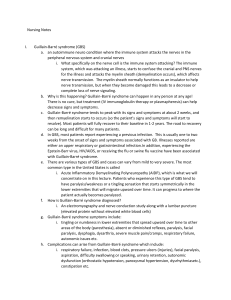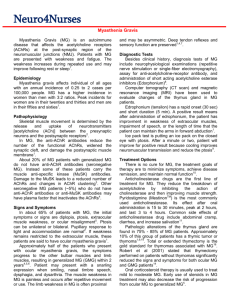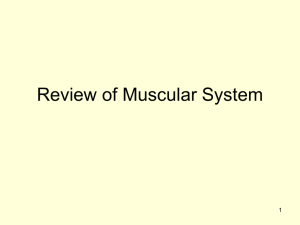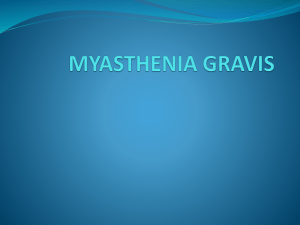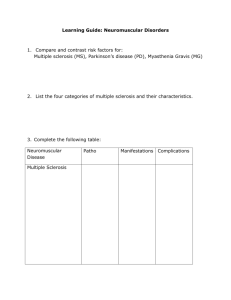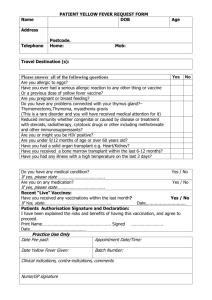Myasthenia gravis
advertisement
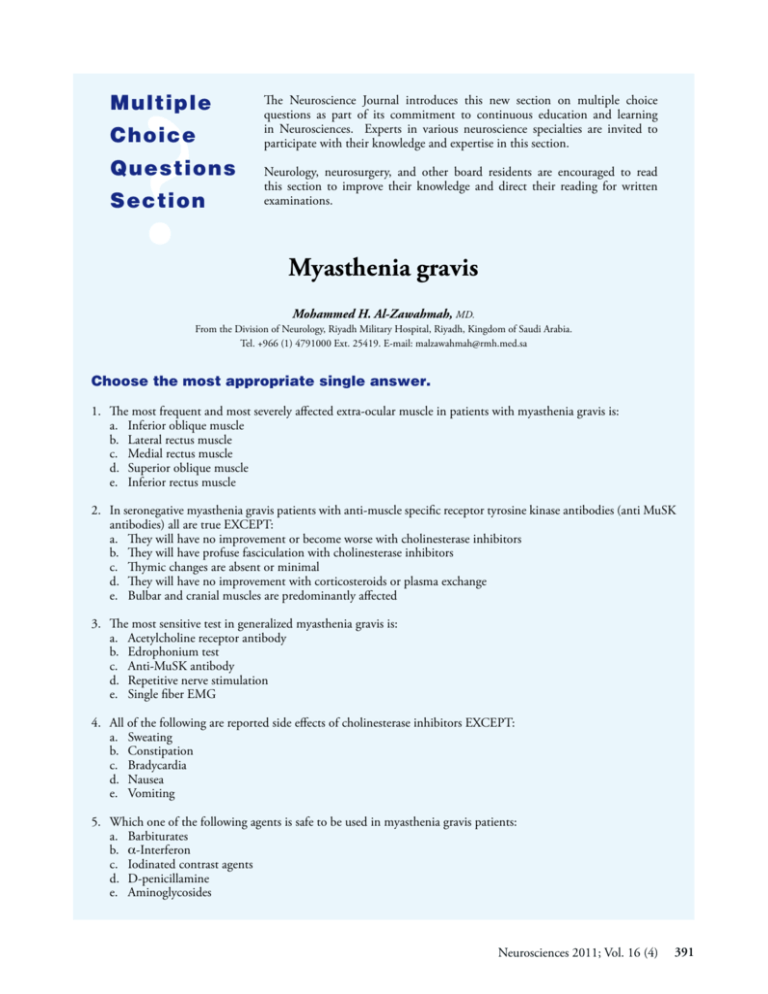
? Multiple Choice Questions Section The Neuroscience Journal introduces this new section on multiple choice questions as part of its commitment to continuous education and learning in Neurosciences. Experts in various neuroscience specialties are invited to participate with their knowledge and expertise in this section. Neurology, neurosurgery, and other board residents are encouraged to read this section to improve their knowledge and direct their reading for written examinations. Myasthenia gravis Mohammed H. Al-Zawahmah, MD. From the Division of Neurology, Riyadh Military Hospital, Riyadh, Kingdom of Saudi Arabia. Tel. +966 (1) 4791000 Ext. 25419. E-mail: malzawahmah@rmh.med.sa Choose the most appropriate single answer. 1. The most frequent and most severely affected extra-ocular muscle in patients with myasthenia gravis is: a. Inferior oblique muscle b. Lateral rectus muscle c. Medial rectus muscle d. Superior oblique muscle e. Inferior rectus muscle 2. In seronegative myasthenia gravis patients with anti-muscle specific receptor tyrosine kinase antibodies (anti MuSK antibodies) all are true EXCEPT: a. They will have no improvement or become worse with cholinesterase inhibitors b. They will have profuse fasciculation with cholinesterase inhibitors c. Thymic changes are absent or minimal d. They will have no improvement with corticosteroids or plasma exchange e. Bulbar and cranial muscles are predominantly affected 3. The most sensitive test in generalized myasthenia gravis is: a. Acetylcholine receptor antibody b. Edrophonium test c. Anti-MuSK antibody d. Repetitive nerve stimulation e. Single fiber EMG 4. All of the following are reported side effects of cholinesterase inhibitors EXCEPT: a. Sweating b. Constipation c. Bradycardia d. Nausea e. Vomiting 5. Which one of the following agents is safe to be used in myasthenia gravis patients: a. Barbiturates b. a-Interferon c. Iodinated contrast agents d. D-penicillamine e. Aminoglycosides Neurosciences 2011; Vol. 16 (4) 391 Myasthenia gravis Answers: 1. c Most patients with myasthenia gravis have weakness of ocular muscles. Asymmetrical weakness of several muscles in both eyes is typical. Weakness is most frequent and is usually most severe in the medial rectus muscles.1 2. d Many patients with anti-MuSK antibodies do not improve with a cholinesterase inhibitor, and many will have profuse fasciculation. Most improve dramatically with plasma exchange and corticosteroids.1,2 3. e Single fiber EMG is the most sensitive test for diagnosis of myasthenia gravis, but may be abnormal in primary nerve or muscle disease. The finding of normal jitter in a clinically weak muscle rules out a defect in neuromuscular transmission as a cause for weakness in that muscle.1,3 4. b Pyridostigmine, the most used cholinesterase inhibitor is generally well tolerated, but even at the commonly used doses, most patients experience muscarinic side effects of nausea and abdominal cramps. Diarrhea, not constipation may become intolerable in some.1,4 5. a a-Interferon and D-penicillamine should never be used in patients with myasthenia gravis. Aminoglycosides and iodinated contrast agents produce worsening of myasthenic weakness in most patients, and should be used with caution. Although it had been reported that barbiturates may exacerbate weakness in myasthenic patients, it will be the least drug to exacerbate myasthenic weakness.1,5 References 1.Sanders DB, Howard JF Jr. Disorders of neuromuscular transmission. In: Bradley WG, Daroff RB, Fenichel GM, Jankovic J, editors. Neurology in Clinical Practice: The Neurological Disorders. 5th ed. Philadelphia (PA): Butterworth Heinemann Elsevier; 2008. p. 2383-2402. 2.Guptill JT, Sanders DB, Evoli A. Anti-MuSK antibody myasthenia gravis: clinical findings and response to treatment in two large cohorts. Muscle Nerve 2011; 44: 36-40. 3.Meriggioli MN. Myasthenia gravis: immunopathogenesis, diagnosis, and management. Continuum: Lifelong Learning in Neurology 2009; 15: 35-62. 4.Kumar V, Kaminski H. Treatment of Myasthenia Gravis. Curr Neurol Neurosci Rep 2011; 11: 89-96. 5.Pascuzzi RM. Medications and myasthenia gravis. A reference for healthcare professionals. New York (NY): Professional and Public Information Committee, Myasthenia Gravis Foundation of America; [updated 2007 Jan; accessed 2011 Aug 31]. Available from: http://www.myasthenia.org/LinkClick.aspx?fileticket=JuFvZPPq2vg%3d. 392 Neurosciences 2011; Vol. 16 (4)

